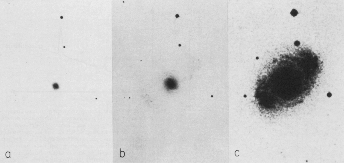
4. SEYFERT GALAXIES
A Seyfert galaxy (named after Karl Seyfert, who published a list of them in 1943) is a spiral galaxy with an exceptionally bright star-like nucleus and a spectrum dominated by prominent emission lines (unlike the spectra of most spiral galaxies, which are dominated by continuum and a few absorption lines).

The picture above shows three successively deeper optical exposures of the Seyfert galaxy NGC4151. In the underexposed image on the left, we see only the luminous star-like nucleus; while in the overexposed image on the right the nucleus is washed out but we can see that it is at the center of a spiral galaxy.
Astronomers classify Seyfert galaxies into two types, depending on the widths of their emission lines. Type I Seyferts have broad emission lines with widths indicating gas velocities of thousands of km/s, while Type II Seyferts have narrower emission lines, indicating velocities of less than a few hundred km/s.
We think the difference between the two types of Seyfert galaxies is just a matter of viewing aspect. If we see the galaxy nearly face-on, we can see broad emission lines from very rapidly moving gas near the center; but if the galaxy is tilted so that the center is obscured by dust, we only see narrow emission lines from more slowly moving gas that is more distant from the center, as illustrated in this outline summary:
Seyfert galaxies.Most Seyfert galaxies are luminous X-ray sources, and sometimes the X-ray emission varies on timescales as short as minutes. We believe that the emission lines from Seyfert galaxies come from interstellar gas near the nucleus of the galaxy that is illuminated and heated by the X-rays.
We believe that Seyfert galaxies, like all the objects we discuss in these lessons, are powered by supermassive black holes at their centers. Recently, the Hubble Space Telescope has found more evidence that NGC4151 has such a black hole; see
Fireworks in a Black Hole near the core of Seyfert galaxy NGC4151.(Return to course home page)
Last modified November 10, 2000
Copyright by Richard McCray